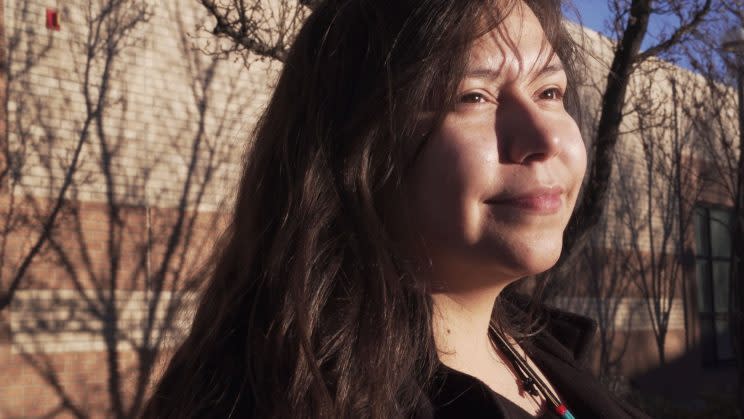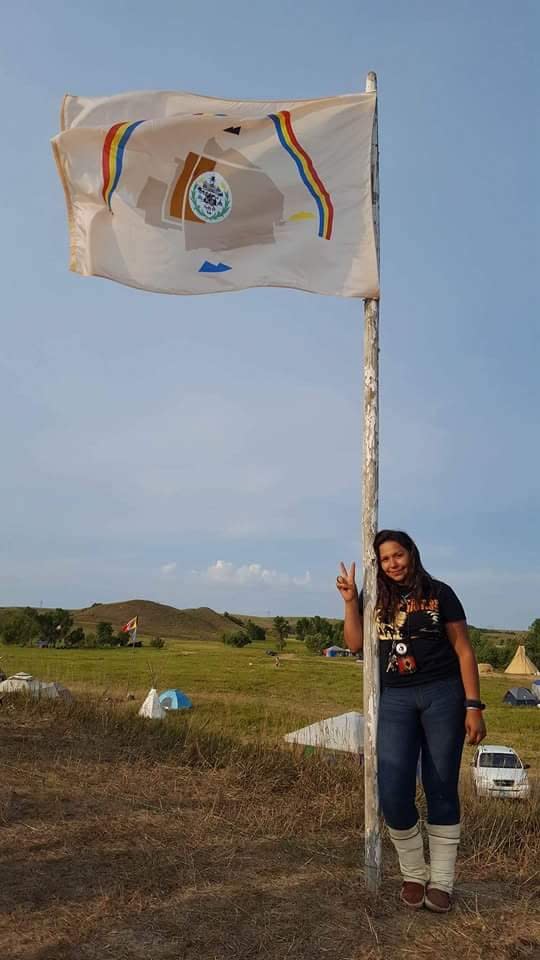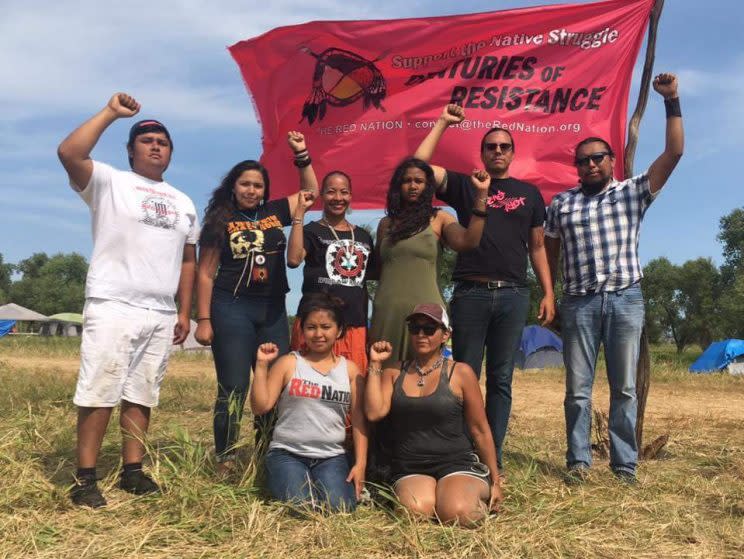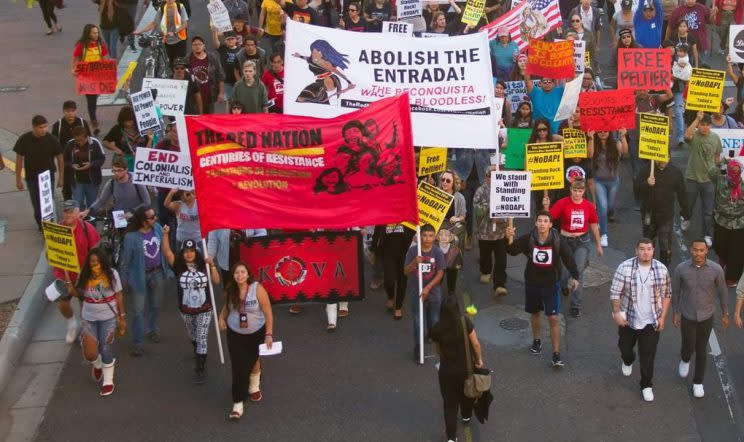Poor, Abused, and Homeless: One Native Woman's Story Growing Up in a U.S. 'War Zone'

The neighborhood was known in Albuquerque as the “War Zone,” and the squat concrete building at the end of the road, its paint peeling in the New Mexico sun, didn’t do much to try and dispel the nickname.
But back then, the building was the only homeless shelter in the area that would take kids without a parent’s signature, so it was the only place she could go in order to stop sleeping out on park benches or inside the slide at the school playground.
Then she could focus on her future, her schoolwork, her 4.2 GPA, her college applications. She could stop running for a change — from her violent mom, her mom’s creepy addict boyfriend, their drug-filled, filth-ridden home, and an existence that had, for her entire life, been one of rootlessness, homelessness.
The War Zone could actually be the way forward.
It seems almost too perfect, now, that her name was Hope. “I was really surprised I made it this far. I didn’t think I was going to make it to 16 because of the circumstances,” she says now, looking up at the building through its chain-link fence.
Hope was born in Albuquerque to a 16-year-old single mom who was homeless.
The family, which quickly included a baby brother, stayed in shelters and with family members until her mom qualified for government help. Her extended family lived hours away, on a Navajo reservation in Chinle, Arizona, one they visited frequently, even for extended periods, but never permanently.
Related: How Native Women Survive the Sex Trafficking Epidemic
About 50% of Native American children are raised in single-parent homes, and nearly three-quarters of those home are considered low-income. For Hope, life as a young Navajo girl, from the time she became one, meant trying to find a home, a place in the world.
It also meant trying to find safety.
Hope’s mother experienced serious violence at the hands of her own parents and Hope’s father, and was, in turn, violent toward Hope and her brother growing up. She would fly into rages at a moment’s notice and react to crying or fear with more rage. Hope says she taught herself to stay calm to make the rages end more quickly. It was a coping method that worked for other problems, like her mom’s boyfriend, who seemed to always smell of alcohol, or seem sort of out of it.
When he moved in, no one really knew about the drugs, but he quickly became as violent as Hope’s mom was, or more so. He fought Hope’s mom, and she fought her kids. There were broken doors, broken glasses. She tried to stay away. School, extracurriculars, studying — anywhere but home.

But she couldn’t ignore some of it. The way he looked at her sometimes. The way her mom had started to dabble in whatever drugs he was selling. The times she slept out and came back to find her mom’s boyfriend in her child-sized bed. One night, when she was 15 and still living in the nice ranch house, he came up to her, started talking closely, started touching her shoulders.
Related: Fighting for Their Lives, Indigenous People Rise Up Around the World
Hope has ways of coping, and this time, she ran. She ran that night down her quiet residential Albuquerque street, and though he chased her, screaming, she made it to a friend’s house, called her mom and told her what had happened.
Her mom picked her up after her graveyard shift, around 2 a.m. And then she brought her home. It didn’t take Hope long to decide that it was safer to be on her own than in her home. That night, running down her sleepy Albuquerque street, running from danger, seeking refuge: that night defined much of Hope’s life for years to come. It may define it forever.

That night — the threat of sexual violence, the presence of drugs and alcohol, the absence of her mom because she was out working late trying to make ends meet, the poverty, the injustice, the search for safety and a home — that’s what Hope is fighting against now.
Native American women experience dramatically higher rates of violence than any other group in the United States — truly staggering rates: 85% of Native women have experienced violence in their lives, 56% have experienced sexual assault, and nearly 40% have experienced sexual assault in the last year.
Related: From Welfare Mom to Author, This Native Woman Defies Statistics
And Like Hope, those experiences of violence often happen at a young age: More than 40% of Native children experience two or more acts of violence by the age of 18. And yet only 13% of reported cases result in arrest, according to the Department of Justice.
Hope’s life was filled with violence — her family was under investigation for 11 years by the state Children Youth and Families Department due to her mother’s physical abuse — but she first became a victim of sexual abuse at the age of 5. After it happened, she started telling adults that she wanted to grow up to be a prostitute after being told that was all she was going to be good for. She was sexually assaulted at ages 14 and 15, and raped when she was a senior in high school.

While Hope’s mom did in fact, get help with her violent outbursts and became less physically abusive, she also got addicted to meth. She got clean again, but the two don’t really talk all that much.
Her family, like many Native families, is fractured but still connected, drawn back to celebrations at her great-grandmother’s house on the reservation. They are still in contact with generations of aunts and cousins and uncles and grandparents, but are broken by the violence and drugs they’ve experienced.
The challenges that Hope faced, statistically, all propelled her to bright future.
When her mom’s boyfriend moved into Hope’s house, she ended up spending more time at school to avoid him. She got there at 6 a.m. to help with clubs and stayed until 8 p.m. for extracurriculars and meetings. If there were a dance one of her committees were helping to organize, she would stay until midnight or 1 a.m. setting up for it — anything to avoid going home.
Related: Take Action – Tell President Trump to Respect Tribal Rights
Hope Alvarado is 21 now, a poised, assured, and eloquent student at the University of New Mexico campus. She’s a student activist, who has decried the racism of the administration and its decision to host Milo Yiannopoulos on campus, and rhapsodized over the next event the Native student group KIVA has planned for indigenous pride on campus. She showed off a pile of donated goods for the water protectors at Standing Rock — she’s been four times since the protests against the Dakota Access Pipeline began — and even introduced herself in her native language, Navajo.
“We introduce ourselves not only as a person but who we are as a community and where we’re from,” she says. “That’s how we greet each other.”
The activism, the passion, the march across campus: they are fueled with this fire, the memories of what happened in this building and before it — the violence of her childhood, the homelessness and poverty. Hope’s identity as young Navajo activist is tied up in the trauma of growing up Native in the US today, with all of the systemic challenges and inequities that brings.
At the Oceti Sakowin camp on the Standing Rock Sioux Reservation last year, Hope stood with thousands of others just like her.
Hope is part of a new generation of young Native American women who, by being at the frontlines of the activists’ movement unified in standing up for their rights, are overcoming the systemic challenges of poverty, substance abuse, mental health challenges, domestic and sexual violence, health and educational inequities, marginalization and racism.
Together, they are standing together with a message that Native people deserve to be heard.
And for a change, the world finally seems to be hearing them.
Read the rest of Hope’s story and the inspiring tales of other activists like her in Global Citizen’s project: Native Girls Rise: How a New Generation of Native Women are Standing Up & Fighting Back.
Read More from Global Citizen:
28 Girls Killed in Orphanage Fire in Guatemala After Protests Over Abuse, Overcrowding
Child Sex-Trafficking Victims Treated as Criminals in Most US States, Advocates Say
Orphanage Sells Babies for $2K, Tells Mothers Their Children Were Stillborn

